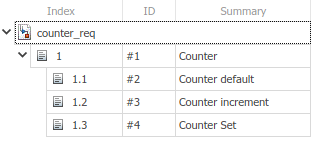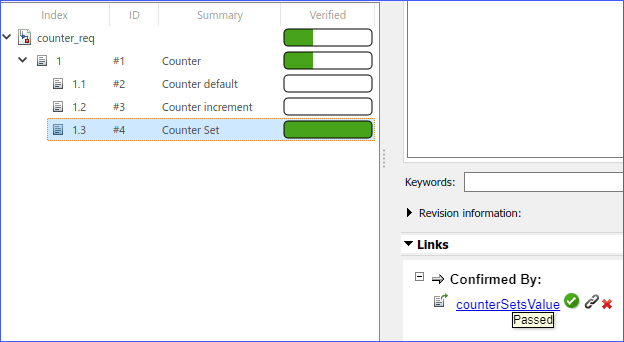集成来自外部结果文件的结果
在此示例中,您将需求链接到 Excel® 格式的结果文件。需求编辑器中的验证状态反映了测试结果。此示例执行 链接到结果文件 中描述的步骤。此示例使用名为 counter_req 的需求集文件和名为 results.xlsx 的测试结果文件。该文件包含一个名为 counterSetsValue 的测试用例。
注册自定义文档接口
在创建链接之前,您需要注册自定义文档接口。在需求编辑器中打开需求文件 counter_req.slreqx。
myReqSet = slreq.open("counter_req.slreqx");
注册特定于外部结果文件 custom_myexcelresults.m 的自定义文档接口。
rmi register custom_myexcelresults
GetResultFcn 函数中的自定义逻辑找到与测试用例相对应的结果文件并从该结果文件中获取结果。如果注册命令返回任何警告,则必须取消注册该文件并再次运行该命令。要取消注册该文件,请输入 rmi unregister custom_myexcelresults。
创建链接
使 struct 包含外部结果的属性。
externalSource.id = "counterSetsValue"; externalSource.artifact = "results.xlsx"; externalSource.domain = "custom_myexcelresults";
与该链路相关的需求其 SID 设置为 4。查找与该链接相关的需求。
requirement = find(myReqSet,Type="Requirement",SID=4);创建链接。
link = slreq.createLink(requirement,externalSource);
此命令创建测试用例 counterSetsValue 与 SID 为 4 的需求之间的链接。在需求编辑器中,链接出现在右侧窗格中的链接下。

注意: 为了避免结果过时,请确保结果文件的时间戳比链接创建的时间戳更新。打开结果文件,在文件中进行虚拟更改并再次保存以获取最新的时间戳。
查看验证状态
要查看验证状态,您需要先更新需求集的验证状态。在 MATLAB® 命令提示符下,键入:
updateVerificationStatus(myReqSet)
要在需求编辑器中查看验证状态列,请在视图部分中选择列 > 验证状态。更新后,获取需求的验证状态:
status = getVerificationStatus(myReqSet)
status = struct with fields:
failed: 0
justified: 0
none: 2
passed: 1
total: 3
unexecuted: 0
打开需求编辑器查看验证状态:
myReqSet = slreq.open("counter_req.slreqx");需求编辑器显示需求集每个需求的验证状态。

counterSetsValue 的需求的验证状态已完全验证。

验证状态显示,三项测试中,有一项测试通过。在视图部分,点击刷新以查看需求编辑器中需求验证的状态。
取消注册自定义文档接口。
rmi unregister custom_myexcelresults